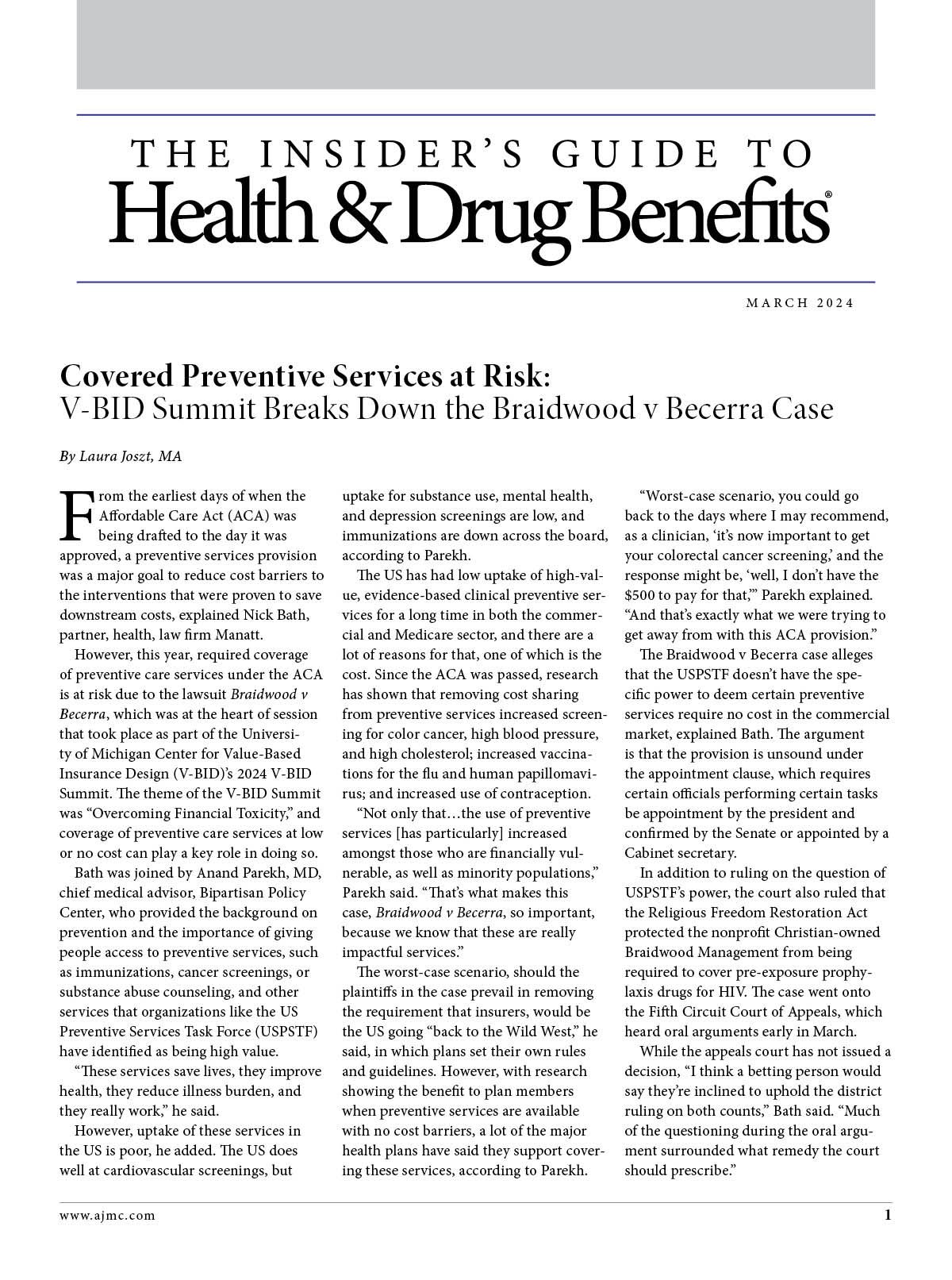- Center on Health Equity & Access
- Clinical
- Health Care Cost
- Health Care Delivery
- Insurance
- Policy
- Technology
- Value-Based Care
Covered Preventive Services at Risk: V-BID Summit Breaks Down the Braidwood v Becerra Case
For more than a decade, certain high-value preventive care services have been covered at no cost to patients under the Affordable Care Act, but a current legal challenge has the coverage at risk.
From the earliest days of when the Affordable Care Act (ACA) was being drafted to the day it was approved, a preventive services provision was a major goal to reduce cost barriers to the interventions that were proven to save downstream costs, explained Nick Bath, partner, health, law firm Manatt.
However, this year, required coverage of preventive care services under the ACA is at risk due to the lawsuit Braidwood v Becerra, which was at the heart of session that took place as part of the University of Michigan Center for Value-Based Insurance Design (V-BID)’s 2024 V-BID Summit. The theme of the V-BID Summit was “Overcoming Financial Toxicity,” and coverage of preventive care services at low or no cost can play a key role in doing so.
Bath was joined by Anand Parekh, MD, chief medical advisor, Bipartisan Policy Center, who provided the background on prevention and the importance of giving people access to preventive services, such as immunizations, cancer screenings, or substance abuse counseling, and other services that organizations like the US Preventive Services Task Force (USPSTF) have identified as being high value.
Anand Parekh, MD
Image credit: Bipartisan Policy Center

“These services save lives, they improve health, they reduce illness burden, and they really work,” he said.
However, uptake of these services in the US is poor, he added. The US does well at cardiovascular screenings, but uptake for substance use, mental health, and depression screenings are low, and immunizations are down across the board, according to Parekh.
The US has had low uptake of high-value, evidence-based clinical preventive services for a long time in both the commercial and Medicare sector, and there are a lot of reasons for that, one of which is the cost. Since the ACA was passed, research has shown that removing cost sharing from preventive services increased screening for color cancer, high blood pressure, and high cholesterol; increased vaccinations for the flu and human papillomavirus; and increased use of contraception.
“Not only that…the use of preventive services [has particularly] increased amongst those who are financially vulnerable, as well as minority populations,” Parekh said. “That’s what makes this case, Braidwood v Becerra, so important, because we know that these are really impactful services.”
The worst-case scenario, should the plaintiffs in the case prevail in removing the requirement that insurers, would be the US going “back to the Wild West,” he said, in which plans set their own rules and guidelines. However, with research showing the benefit to plan members when preventive services are available with no cost barriers, a lot of the major health plans have said they support covering these services, according to Parekh.
“Worst-case scenario, you could go back to the days where I may recommend, as a clinician, ‘it's now important to get your colorectal cancer screening,’ and the response might be, ‘well, I don't have the $500 to pay for that,’” Parekh explained. “And that's exactly what we were trying to get away from with this ACA provision.”
Nick Bath
Image credit: Manatt

The Braidwood v Becerra case alleges that the USPSTF doesn’t have the specific power to deem certain preventive services require no cost in the commercial market, explained Bath. The argument is that the provision is unsound under the appointment clause, which requires certain officials performing certain tasks be appointment by the president and confirmed by the Senate or appointed by a Cabinet secretary.
In addition to ruling on the question of USPSTF’s power, the court also ruled that the Religious Freedom Restoration Act protected the nonprofit Christian-owned Braidwood Management from being required to cover pre-exposure prophylaxis drugs for HIV. The case went onto the Fifth Circuit Court of Appeals, which heard oral arguments early in March.
While the appeals court has not issued a decision, “I think a betting person would say they’re inclined to uphold the district ruling on both counts,” Bath said. “Much of the questioning during the oral argument surrounded what remedy the court should prescribe.”
Assuming the Supreme Court, which leans conservative same as the Fifth Circuit Court of Appeals, will agree, the question arises: how does one cure the appointments clause issue? The solution would have to be legislative and a bipartisan fix required. Coverage of these preventive services has enormous popularity. “They're baked into the cake now; no one expects to pay for these,” Bath said.
He added that the last 15 years have clearly shown people don’t like it when something they have is taken away, especially in health care. However, there are obstacles. These benefits have been in existence for a long time, but the fact that the cost has disappeared from peoples’ out-of-pocket liability “makes them somewhat invisible,” Bath explained.
“To put it simply, people take [covered preventive services] for granted and may not know where they came from,” he said. “In fact, they probably don’t.”
In addition, there aren’t huge cost saving associated with covering preventive services. The Congressional Budget Office does not want to assign large, downstream federal savings in the form of avoided medical care partly because there is the assumption that insurance plans will continue to cover these services even if the provision goes away.
While there does seem to be evidence that many plans will still cover these services, things change. “What happens when a screening test for cancer arises, for which the price is something unexpected? I think the plan and self-insured [employer] dynamic may look a little different because they have fiduciary duties, not because they're bad people,” Bath said.
Ultimately, he thinks that after a long appeal, which could take to the end of 2025, the appointments clause issue will land in Congress’ court. However, his concern is that this will no longer be a priority anymore and that there is no bipartisan consensus foundation on which to proceed for addressing the issue.
At the end of the session, Parekh urged attendees to make coverage of preventive care services a top priority. “At the end of the day, we all care about health, and these are services that save lives, they do help.”

